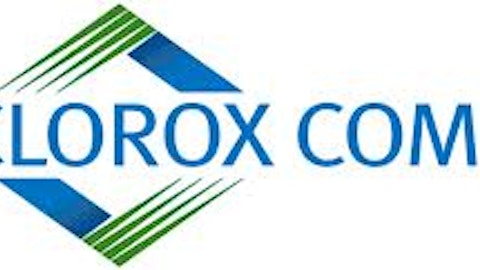The Clorox Company (NYSE:CLX) is home to some of the most profitable brands in the world, but many investors fear that the company’s recent revenue weakness is a sign of a worrisome consumer shift toward private-label products. The Clorox Company (NYSE:CLX) derives most of its economic profit from brand equity alone, so if consumers decide brands are no longer important, then Clorox’s moat is toast.
Can private labels undercut iconic brands?
The Clorox Company (NYSE:CLX), Hidden Valley, and Brita are just a few of the market-leading consumer brands in Clorox’s portfolio. The company has historically generated high returns on capital — in the 20% to 30% range — because the earning power of its brands now far exceed the necessary marketing and research spending necessary to maintain the brands’ value. In a way, The Clorox Company (NYSE:CLX)’s portfolio of brands is like a stock portfolio that compounds at over 20% each year — that’s pretty valuable.

Worried investors point to the company’s dependence on just a handful of retail channels; five retailers accounted for 44% of Clorox’s revenues in 2012, including 26% through Wal-Mart. If any of its top five retailers were to drop Clorox’s brands entirely, the company’s value would be significantly impaired.
However, a large abandonment of The Clorox Company (NYSE:CLX)’s products is unlikely. Strong brands drive traffic to stores, and stores that do not carry certain brands will get less traffic. If a customer cannot buy Clorox bleach at Target, that customer may go to Wal-Mart for bleach and the rest of her shopping items.
More likely, shelves will become more and more crowded with private-label products receiving more prominent placement than they were traditionally given. The Clorox Company (NYSE:CLX) has taken steps to reduce exposure to product categories — like trash bags — where consumers care more about price than brand.
But the majority of the company’s brands should remain relatively immune to the private-label trend. Since 2005, the company has aggressively raised prices across the board, with nearly all of the price increases still in place today. This would not be possible if the company’s brands were under fire from knock-offs.
Margins are under pressure, but not from private labels
Private-label products are a minor annoyance for Clorox, not a moat destroyer. The real pressure on margins comes from rising input costs, which have also affected rivals The Procter & Gamble Company (NYSE:PG) and Kimberly Clark Corp (NYSE:KMB).

The Procter & Gamble Company (NYSE:PG)’s brands include Tide, Charmin, and Iams. Its brand portfolio is much larger than Clorox’s; it has $84 billion in sales compared to Clorox’s $5.6 billion. The Procter & Gamble Company (NYSE:PG) also has a much larger geographic footprint, but is now regretting its aggressive expansion into emerging markets and is backtracking to refocus on developed economies with more brand-conscious consumers.
In addition to rising input costs, The Procter & Gamble Company (NYSE:PG)’s margins are under pressure from its bloated cost structure due to the company’s over-extension, but its retreat from emerging markets will enable the company to trim a lot of fixed costs. As a result, P&G is in the same boat as Clorox — strong brands under temporary profitability pressure.
The story is different for Kimberly Clark Corp (NYSE:KMB), however. Like Clorox and The Procter & Gamble Company (NYSE:PG), Kimberly Clark Corp (NYSE:KMB) owns a portfolio of market-leading brands, including Kleenex, Huggies, and Kotex. However, the company has struggled to maintain its margins more than Clorox and P&G because consumers are more willing to buy off-brand tissues and similar items during periods of economic distress. The protracted high underemployment rate causes additional strain on the company’s profitability.
Kimberly Clark Corp (NYSE:KMB)’s margins are already much lower than Clorox’s. This is the difference between brand loyalty and brand preference — consumers demand Clorox’s brands, but only prefer Kimberly Clark Corp (NYSE:KMB)’s. As a result, consumers will continue to purchase higher-priced products from Clorox and The Procter & Gamble Company (NYSE:PG), but Kimberly Clark Corp (NYSE:KMB)’s margins will come under pressure from private-label products.
Bottom line
Despite recent weakness in revenue and margins, The Clorox Company (NYSE:CLX)’s moat remains intact due to strong consumer loyalty to its brands. Few moats last forever, but Clorox’s will not disappear any time soon.
The article Is This Iconic Company’s Moat Disappearing? originally appeared on Fool.com and is written by Ted Cooper.
Ted Cooper has no position in any stocks mentioned. The Motley Fool recommends Kimberly-Clark and Procter & Gamble.
Copyright © 1995 – 2013 The Motley Fool, LLC. All rights reserved. The Motley Fool has a disclosure policy.





